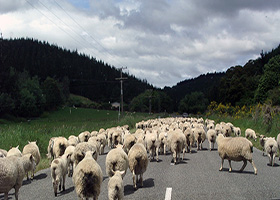


For example, Scott recently likened the behavior of funds that adopt traditional 60/40 asset mixes to herding buffalos:
“It is much easier to run with the herd – in the middle, it is very warm. And it is still easier to run on the edge than it is to go outside the herd.”
His message: Running with the herd may feel great while you’re doing it…until the herd runs off a cliff together. And if you’re a fund adopting a 60/40 approach, you’re a buffalo in a herd. You’re not really thinking through the risks in your portfolio; you’re just doing what everybody else is doing.
Here’s Scott again:
“When I started at the Alaska Permanent Fund two and a half years ago, the focus on risk was predominantly about dollar allocations and manager allocations…The asset allocation was designed via the Markowitz mean variance optimisation model. Given the assumptions and instability in returns and correlations, the model is not really practical, but that’s what the public space is using. I wonder if Warren Buffett or George Soros are using the Markowitz model?”
Scott was determined to revitalize APF’s operations. How’d Scott do it? Sophisticated risk management, good investment governance and education:
“It is clearly an education process. Trustees have to re-focus on how much risk to undertake and how you will structure that risk, along with a prudent governance policy…I am not trying to fight yesterday’s battles, but many public funds were too focused on picking managers rather than focusing on the tougher issues of risk allocation and governance…The trustees are now concerned with governance policy, risk management, and broad asset allocation…The trustees, as a group, may not have the background for picking managers or markets. However, what they do have is the trust of their constituents and the skill to build a sound governance policy.”
Scott has done an award winning job (literally) at APF. He has adeptly educated and convinced the trustees and politicians of his plans. The APF now has an intelligent investment decision-making process tailored to its specific needs. It is, today, a buffalo beyond the herd.
This post originally appeared on the Oxford SWF Project website.
